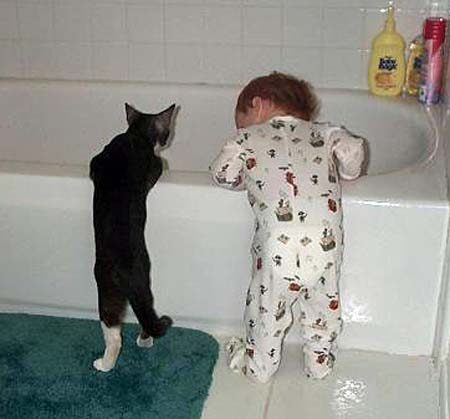House Cats and Kids

House cats and kids ...cat info on how to avoid cat problems with kids. Cats are fascinating to toddlers; they jump and run, stimulating the chase. Plus, they have high voices, large eyes and fluffy hair. Cats seem to see babies and toddlers as a different species.
Young children are wider and shorter than older kids or adults. They have large heads in proportion to their bodies; they have shrill voices and they smell of pabulum and baby powder. A cat who is raised with adults regards kids with dismay. Toddlers seem to view cats as toys.
Preschoolers through first-graders perceive their pets as playmates; third through fifth graders see the family cat as a confidant and source of emotional support; and adolescents see cats as special friends and surrogate children. In spite of the many positive roles feline companions play in children’s lives, however, the house cats and kids connection can go crazy. It is up to parents to teach responsible relationship skills to both house cats and kids.
When you’re selecting new kittens or cats to add to your family, try to investigate their social backgrounds. If the kitten or cat was raised by a mother who brought her litter into the human family circle, the offspring seem to attach naturally to people. Cats raised in families with children are more tolerant of youngsters than those that haven’t been exposed to little people.
Socialization is the process whereby cats learn to relate to others, human and animals, in their group. This process begins at around 2 weeks of age and extends past weaning. Research suggests that what kittens are exposed to during this time makes a lasting imprint on them that is carried with them though-out life. You will have better luck with the house cats and kids combination.
Allow young children, with proper adult supervision, to play for limited periods with kittens if their mother permits it. The kittens will learn to tolerate and enjoy all kinds of interactions with kids, and the children will learn to be nurturing and gentle with the kittens.
Play is said to be the “work” of children. The same is certainly true for kittens. Through play with litter-mates and human siblings, kittens learn to control how hard they bite and to retract their claws to prevent injury to their playmates.
During this same formative period in a kitten’s life, he is imprinting on his environment. Kittens in cluttered rooms receive more stimulation than those raised in neat, tidy rooms. Paper bags left on the floor and clothes draped over the furniture provide objects for play and interaction. House cats and kids have similarities with toys.
House cats and kids can get you frustrated about what a mess they are making but knowing that the kids are providing stimulation for kitty’s development might make living with them more tolerable.
They’re also socializing the young feline to loud rock music and other environmental stimuli associated with human adolescents, which means that your cat will always be a bit more comfortable with any teenagers than they would be otherwise.
In the same way that kittens exposed to noise and children will grow up to enjoy interacting with youngsters, kittens experiencing frightful situations…a traumatic experience with a toddler jabbing a finger in his eye, for example…may develop a fear of children.
The most vulnerable period for fear imprinting is 7 to 14 weeks of age, and cat owners should take special care to ensure that encounters with house cats and kids during this time are pleasant.
Since kittens shouldn’t be taken away from their mothers before they are 8 weeks old, many people adopt kittens after the prime socialization period has passed and must depend to a large extent upon the mother cat’s owners to socialize the kittens to people. Attachments and preferences can be changed later, but it’s a more tedious process.
Choosing an adult cat can often save a rescued (and often older cat) and selecting an adult short-haired cat means you won’t spend as much time grooming them. Plus, you have a fair idea of the cat’s personality which is already mostly formed, so you don’t have many surprises a year down the road like you might with a developing kitten. House cats and kids raised together have an inherent knowledge of the others body language, voice timbre, and communicative efforts.
However, misunderstandings occur. Parents should teach the basics of feline communication such as a cat that appears agitated and begins swishing his tail rapidly back and forth isn't wagging his tail like a dog….he’s saying in cat language that he’s angry. A deep hiss is a more aggressive feline vocal tone than a high-pitched meow. Ears flattened back against a cat’s head indicate that he’s extremely upset.
Offer children guidelines for preventing injury to themselves or stress to the cat. If the kitty appears aggressive, as evidenced by body language and voice pitch, have children back away quietly and leave the cat alone. Teach children not to bother a cat who is sleeping or eating, or using the litter. Show them how to handle animals gently and with respect.
Parents and children should consider also the cat’s physical needs and be prepared to supply them; safe toys; a break-away collar with tags; high quality food; plenty of fresh water; a carrier for trips to the vet; a kitty comb; a scratching post; litter trials to determine the cat’s litter preference; annual veterinary examinations and vaccinations; and an appointment for neutering or spaying.
Some situations take time so if your adding children to your household through birth, adoption, or prolonged visits, start introducing your resident cat (or cats) to kids as early as possible…before a baby is brought home from the hospital or the toddler comes for the holidays.
House cats and kids need time to adjust. Cats assess their environment with their senses. Therefore, try to introduce babies into your cat’s world before the birth of your own through vision, smell, and sound.
Allow your cat to see and smell the new equipment such as the changing table, crib, diaper bag, and so forth. Expose the cat to the scent of baby powder, baby oil, formula, and diapers, and the sounds of rattles, as well as recordings of a baby crying. Begin by playing the recording at a low volume, gradually increasing the sound until the louder levels of crying elicit no response from the cat.
Play the low volume recording for five minutes the first day. If the cat doesn't react, increase both playing time and volume the next day. If the cat appears apprehensive or uneasy, return to a previous volume and recording time. You might also borrow a baby from a friend; most new parents are more than willing to give up junior for a couple of hours while they take a nap.
Let your cat see and hear you cuddling and cooing with the infant. At the same time, have your spouse hold and cuddle the cat. Change places with your spouse…you hold and cuddle the cat while your husband interacts with the baby. The goal is to have the cat associate the baby with more, not less, attention from family members. This activity will lead to the success of house cats and kids interacting better.
Before the baby comes home from the hospital, bring a piece of the child’s clothing home so the cat gets used to the smell. After the baby comes home from the hospital, parents should supervise encounters between house cats and kids…in this instance…an infant. Never leave the baby alone with the cat, and keep kitty out of the nursery while the baby is sleeping until the child is old enough to sit up.
Baby supply stores offer zip-up safety nets which fit over cribs, creating a barrier between the infant and the cat. This is simply to protect the baby from an overzealous cat. Another physical barrier to consider are cat nails, the vinyl shields which fit over the cat’s nails and are available at pet supply stores.
Having a new baby in the house can be stressful to all family members, including felines. It may be difficult, but try to maintain your routine with the cat…feed kitty at the same time, play ball at the same time, groom the cat as usual, and try to give him as much attention and quality time as possible.
Even before the baby arrives, establish a nook or room which the cat can consider his sanctuary. This area should be furnished with a bed, blanket with your scent, and a few kitty toys. This is a place where the cat can escape the sounds of a newborn crying or a toddler touching him.
In a situation where you are getting a cat for an older child, let the child read a book on cat care and let the child help you select the cat. Again, rescuing a cat from the shelter is a good choice. You can both pick out the one you want and see that it’s already socialized around people. When introducing a new cat to his human family, ensure that all parties…feline and human…are sheltered from frightening experiences.
Pick a room and let the new kitty explore it alone. Leave a few items carrying the family members’ scents. The cat will look for its escape routes. After a while, slip into the room and sit quietly on the floor. Let the cat have the option of making the personal introductions. A cat in control of approaching a child is less likely to feel threatened or cornered.
I suggest that a parent be present to supervise the first few encounters between the pet and child. In a short time the child and cat will make friends. Education about cats, careful selection of the right feline companion and a cautious introduction of the pet helps ensure that house cats and kids plus parents….will have a happy relationship.
Related Articles......
Return from House Cats and Kids to Cat Health Homepage
Having trouble finding what you need? Cat Health Index & Site Map
OR
Do you have a question to ask?...Questions
OR
Do you have a cat story to share?...Simply click here to go to that page!
Copyright@2010-2020 All rights reserved.Cat-health-detective.com
This website is information only. Consult a veterinarian for medical assistance

"Like Us" on Facebook
or...
"Like Us" here




















